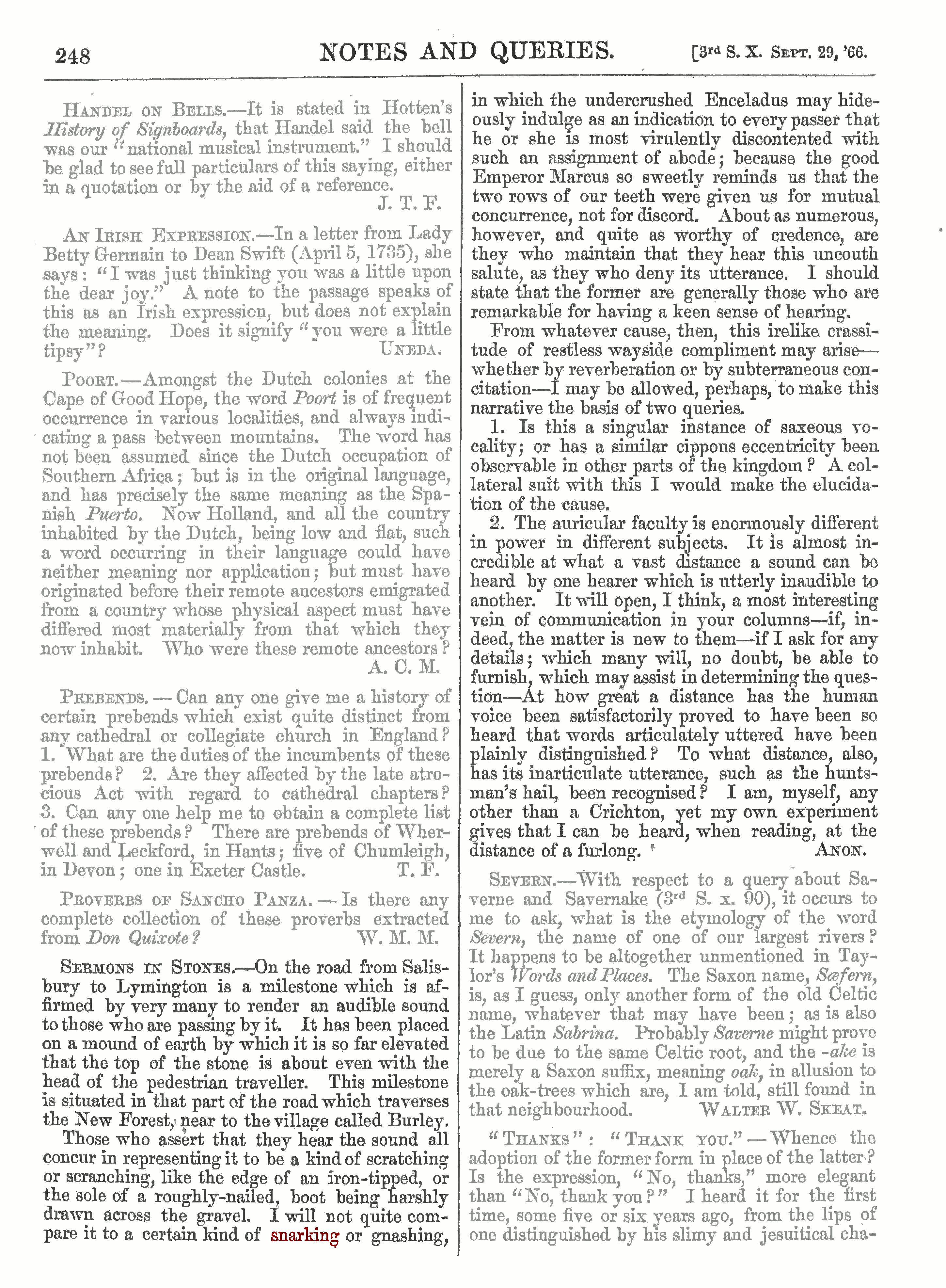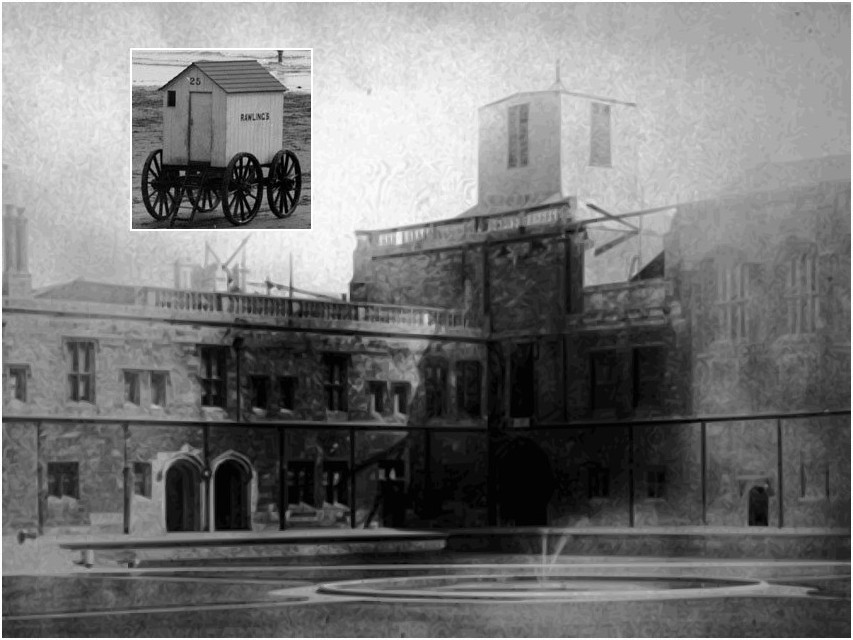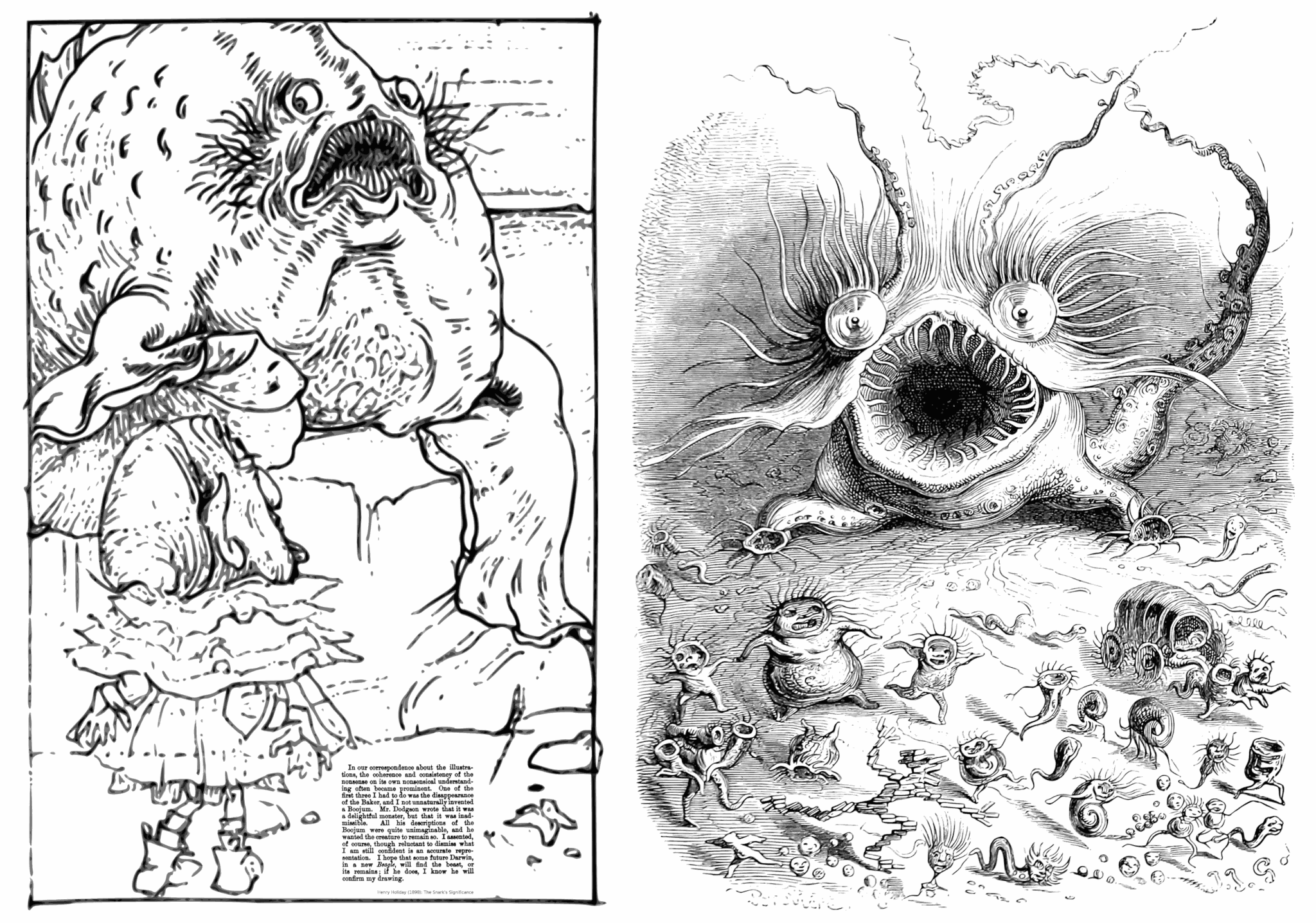The onomatopoeic word “snarking” already had been used in the year 1866.

2017-08-28, updated: 2023-03-24
Lewis Carroll, Henry Holiday and Joseph Swain's Tragicomedy
The onomatopoeic word “snarking” already had been used in the year 1866.

2017-08-28, updated: 2023-03-24
How can we recognize a Snark? The Bellman explains it (🎶🎶🎶): A Snark is not necessarily evil, but once it turns into a Boojum, you are in trouble.
“Come, listen, my men, while I tell you again
The five unmistakable marks
By which you may know, wheresoever you go,
The warranted genuine Snarks.
“Let us take them in order.
It next will be right
To describe each particular batch:
Distinguishing
※ those that have feathers, and bite,
※ And those that have whiskers, and scratch.
“For, although common Snarks do no manner of harm,
Yet, I feel it my duty to say,
Some are Boojums –” The Bellman broke of in alarm,
For the Baker had fainted away.
…
“He remarked to me then,” said that mildest of men,
“ ‘If your Snark be a Snark, that is right:
Fetch it home by all means – you may serve it with greens,
And it’s handy for striking a light.
“ ‘You may seek it with thimbles—and seek it with care;
You may hunt it with forks and hope;
You may threaten its life with a railway-share;
You may charm it with smiles and soap –’ ”
(“That’s exactly the method,” the Bellman bold
In a hasty parenthesis cried,
“That’s exactly the way I have always been told
That the capture of Snarks should be tried!”)
“ ‘But oh, beamish nephew, beware of the day,
If your Snark be a Boojum! For then
You will softly and suddenly vanish away,
And never be met with again!’
…
“I engage with the Snark — every night after dark —
In a dreamy delirious fight:
I serve it with greens in those shadowy scenes,
And I use it for striking a light:
“But if ever I meet with a Boojum, that day,
In a moment (of this I am sure),
I shall softly and suddenly vanish away —
And the notion I cannot endure!”
Important: The descriptions above are opinions of the Bellman, the Baker and the Baker’s Uncle. The views of these characters are not necessarily Lewis Carroll’s views: “I do not hold myself responsible for any of the opinions expressed by the characters in my book.” (Lewis Carroll, Sylvie and Bruno Concluded). However, the “delirious fight” “every night after dark” could be a reference to the author’s own “mental troubles“.
Among the forks mentioned above (used to hunt the Snark and carried by this landing crew of a naval expedition) is a tuning fork (held by the Banker). Charles Darwin used a tuning-fork to let spiders dance, and for dissection (don’t tell the spiders) he used lace-needles together with his microscope (like the one carried by the beaver).
2017-09-18, edited 2022-11-29
I think that in his description of the five Snark marks, Lewis Carrolls might have referred to some of his contemporaries. After listing the 5th mark “ambition”, Carroll devides Snarks into two types:
It next will be right
To describe each particular batch:
Distinguishing
those that have feathers, and bite,
And those that have whiskers, and scratch.
This could be a reference to the Snark illustrator Henry Holiday and the engraver Joseph Swain, or generally to printmakers who make etchings and engravings. The Snark is not necessarily a bad beast (as long as it doesn’t turn into a Boojum).
2019-03-04, updated: 2022-03-28
The fourth is its fondness for bathing-machines,
Which it constantly carries about,
And believes that they add to the beauty of scenes—
A sentiment open to doubt.

[The New Belfry of Christ Church, Oxford], of the best of Dodgson’s Oxford squibs, a good humored but cutting attack on Dean Liddell (the father of Alice) and the wooden cube built to contain the Cathedral bells during operations to build a new tower. Though it can still be found today behind the stone walls of the tower, the wooden cube was always a temporary plan but Dodgson was impatient and the Governing body were slow.
Source: Cristies, 2009-12-04
The Bell in The Hunting of the Snark might be interpreted as a symbol for time and time pressure. But it also might have been used by C.L. Dodgson to continue lampooning Dean Henry Liddell‘s minimalistic “bonnet-box” project, a meekly geometric belfry to go up on the cathedral at Christ Church. In The New Belfry of Christ Church, a certain “D. C. L.” wrote:
§ 7. On the impetus given to Art in England by the new Belfry, Ch. Ch.
The idea has spread far and wide, and is rapidly pervading all branches of manufacture. Already an enterprising maker of bonnet-boxes is advertising ‘the Belfry pattern’: two builders of bathing-machines[MG025] at Ramsgate have followed his example: one of the great London houses is supplying ‘bar-soap’ cut in the same striking and symmetrical form: and we are credibly informed that Borwick’s Baking Powder and Thorley’s Food for Cattle are now sold in no other shape.
In The Belfry at Christ Church by E.G.W. Bill, edited by Michael Hall and published in Oxoniensia 2013 (Oxfordshire Architectural and Historical Society), I found this quote from a letter by C.L. Dodgson to The Pall Mall Gazette (1874-10-31):
During the restoration of the Cathedral, when the bells had been removed from the tower, which had become too weak to support them, it was proposed to hang them outside the cathedral in a wooden belfry, which we were assured would be quite inoffensive, as it would hardly be visible from any point of the compass. In an evil hour we consented, and the resulting erection, which cost about a thousand pounds, speedily made us famous for having inflicted upon Oxford the ugliest and most conspicuous monstrosity that probably she has ever seen. This, and the great expense already incurred, forced on us the conviction that we must now erect a stone bell-tower.
2018-05-24, update: 2022-11-22
In The New Belfry of Christ Church, a certain “D. C. L.” wrote:
§ 7. On the impetus given to Art in England by the new Belfry, Ch. Ch.
The idea has spread far and wide, and is rapidly pervading all branches of manufacture. Already an enterprising maker of bonnet-boxes is advertising ‘the Belfry pattern’: two builders of bathing-machines[MG025] at Ramsgate have followed his example: one of the great London houses is supplying ‘bar-soap’ cut in the same striking and symmetrical form: and we are credibly informed that Borwick’s Baking Powder and Thorley’s Food for Cattle are now sold in no other shape.
In https://snrk.de/page_the-new-belfry I wrote about that already earlier, but today I found a Twitter thread by Thomas Morris (@thomasngmorris) on C.L. Dodgson’s (Lewis Carroll’s) The New Belfry of Christ Church, Oxford.
I've just come across this very funny but little-known work by Lewis Carroll, published in 1873 under the not-very-anonymous pseudonym 'D.C.L.' (Dodgson, Charles Lutwidge – a rearrangement of his real initials). pic.twitter.com/twNBcahJp1
— Thomas Morris (@thomasngmorris) April 6, 2018
2019-06-08

Monsters, by Henry Holiday (left) and J. J. Grandville (right).
[…] One of the first three [illustrations] I had to do was the disappearance of the Baker, and I not unnaturally invented a Boojum. Mr. Dodgson wrote that it was a delightful monster, but that it was inadmissible. All his descriptions of the Boojum were quite unimaginable, and he wanted the creature to remain so. I assented, of course, though reluctant to dismiss what I am still confident is an accurate representation. I hope that some future Darwin in a new Beagle will find the beast, or its remains; if he does, I know he will confirm my drawing. […]
(Henry Holiday (1898): The Snark’s Significance)
Once you meet the Boojum, you might be Going Slightly Mad.
Even while the blinding bandage lies,
Daughter of a Judge, upon thine eyes,
If the scales thou wield with care
Truth and Justice will declare
Hunting Snarks is innocent and wise!
Inscribed (1876-09-02) with an allusion to Justicia by Lewis Carroll into an edition (now owned by NYU) of The Hunting of the Snark owned by Charlotte Edith Denman, daughter of George Denman.
Source of the acrostic poem:
Rare, Uncollected, Unpublished & Nonexistent Verse of Lewis Carroll, Collected and Annoted by August A. Imholz, Jr. & Edward Wakeling, p. 30, LCSNA 2018, ISBN 978-0-930326-11-1.
The book is available to LCSNA members only.